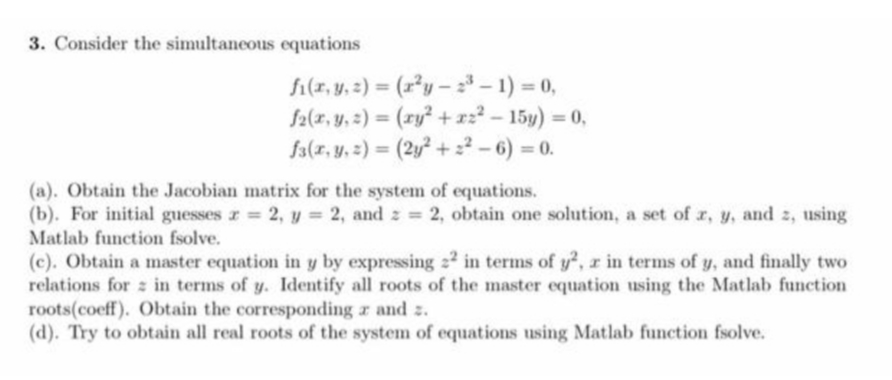3. Consider the simultaneous equations fi(z, y. 2) = (ry- - 1) = 0, f2(x, y, 2) = (xy² +z2-15y) = 0, f3(x, y, =) = (2y² +? – 6) = 0. %3D (a). Obtain the Jacobian matrix for the system of equations.
3. Consider the simultaneous equations fi(z, y. 2) = (ry- - 1) = 0, f2(x, y, 2) = (xy² +z2-15y) = 0, f3(x, y, =) = (2y² +? – 6) = 0. %3D (a). Obtain the Jacobian matrix for the system of equations.
Algebra & Trigonometry with Analytic Geometry
13th Edition
ISBN:9781133382119
Author:Swokowski
Publisher:Swokowski
Chapter9: Systems Of Equations And Inequalities
Section9.7: The Inverse Of A Matrix
Problem 32E
Related questions
Question
P2

Transcribed Image Text:3. Consider the simultaneous equations
fi(z, y, 2) = (ry-- 1) = 0,
f2(r, y, :) = (ry² +xz? – 15y) = 0,
fa(x, y, =) = (2y² + :² - 6) = 0.
%3D
%3D
%3D
%3D
(a). Obtain the Jacobian matrix for the system of equations.
(b). For initial guesses r = 2, y = 2, and z = 2, obtain one solution, a set of r, y, and 2, using
Matlab function fsolve.
(c). Obtain a master equation in y by expressing 2² in terms of y, r in terms of y, and finally two
relations for z in terms of y. Identify all roots of the master equation using the Matlab function
roots(coeff). Obtain the corresponding z and z.
(d). Try to obtain all real roots of the system of equations using Matlab function fsolve.
Expert Solution
This question has been solved!
Explore an expertly crafted, step-by-step solution for a thorough understanding of key concepts.
Step by step
Solved in 2 steps

Recommended textbooks for you

Algebra & Trigonometry with Analytic Geometry
Algebra
ISBN:
9781133382119
Author:
Swokowski
Publisher:
Cengage

Elementary Linear Algebra (MindTap Course List)
Algebra
ISBN:
9781305658004
Author:
Ron Larson
Publisher:
Cengage Learning

Algebra & Trigonometry with Analytic Geometry
Algebra
ISBN:
9781133382119
Author:
Swokowski
Publisher:
Cengage

Elementary Linear Algebra (MindTap Course List)
Algebra
ISBN:
9781305658004
Author:
Ron Larson
Publisher:
Cengage Learning